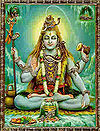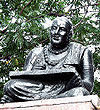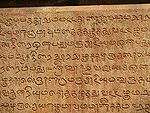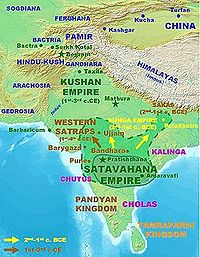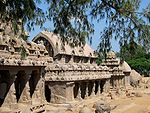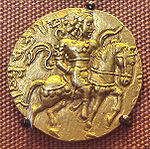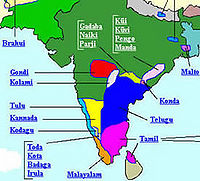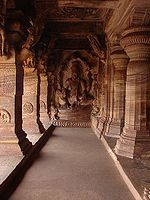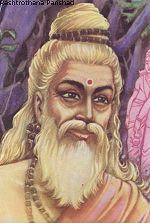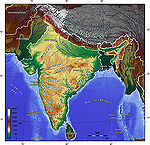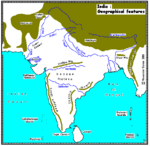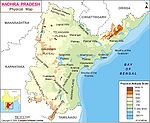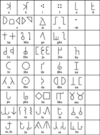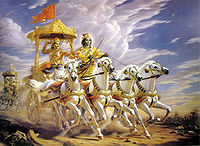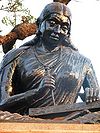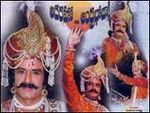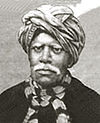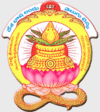Difference between revisions of "Telugu The Language"
Sree Ganesh (Talk | contribs) |
Sree Ganesh (Talk | contribs) |
||
| Line 24: | Line 24: | ||
The most popular explanation for the etymology of the word ''telugu'' (తేలుగు) is that it comes from the word ''Trilinga'' which literally means: ''belongs to the land of three Siva (Hindu god) [[Image:Shiva.jpg|thumb|100px|right| The God Siva (Shiva)]]Temples'' and therefore refers to the three temples at [http://en.wikipedia.org/wiki/Srisailam Srisailam], Drakasharamam, and Kaleshwaram. However, not many scholars accept this view. | The most popular explanation for the etymology of the word ''telugu'' (తేలుగు) is that it comes from the word ''Trilinga'' which literally means: ''belongs to the land of three Siva (Hindu god) [[Image:Shiva.jpg|thumb|100px|right| The God Siva (Shiva)]]Temples'' and therefore refers to the three temples at [http://en.wikipedia.org/wiki/Srisailam Srisailam], Drakasharamam, and Kaleshwaram. However, not many scholars accept this view. | ||
| − | Let us examine some of the other views here. | + | Let us examine some of the other views here. foe testing i am adding this text |
Khandavalli Lakshmi Ranjanam (1962) assumes that the word Telugu comes from the word ''Talaing'' . Since ''tala'' in Telugu refers to head, ''Talaings'' refers to leaders. Probably, ''Talaings'' were a civilization that conquered the people living in the area of current [http://en.wikipedia.org/wiki/Andhra_Pradesh Andhrapradesh]. Hence they had the name ''Talaings''. Later this must have given rise to the words ''Telungu'' and ''Trilinga'' . | Khandavalli Lakshmi Ranjanam (1962) assumes that the word Telugu comes from the word ''Talaing'' . Since ''tala'' in Telugu refers to head, ''Talaings'' refers to leaders. Probably, ''Talaings'' were a civilization that conquered the people living in the area of current [http://en.wikipedia.org/wiki/Andhra_Pradesh Andhrapradesh]. Hence they had the name ''Talaings''. Later this must have given rise to the words ''Telungu'' and ''Trilinga'' . | ||
Revision as of 13:36, 29 March 2011
| Telugu | ||
|---|---|---|
| Template:Lang | ||
| Spoken in | India | |
| Region | Andhra Pradesh | |
| Total speakers | 74 million native speakers as of 2001 | |
| Language family | Dravidian
| |
| Writing system | Telugu script | |
| Official status | ||
| Official language in | Template:IND | |
| Regulated by | not regulated | |
| Language codes | ||
| ISO 639-1 | te | |
| ISO 639-2 | tel | |
| ISO 639-3 | tel | |
| Linguasphere | ||
| Note: This page may contain IPA phonetic symbols in Unicode. | ||
by Sree Ganesh
Error creating thumbnail: Unable to save thumbnail to destination |
This article may require cleanup to be suited for an informational wiki. We try to help with some Best Practice Guidelines for writing on the TypeCraft wiki. You also can leave your comments concerning this message on this template's talk page Talk page. |
Contents
Etymology
The most popular explanation for the etymology of the word telugu (తేలుగు) is that it comes from the word Trilinga which literally means: belongs to the land of three Siva (Hindu god) Temples and therefore refers to the three temples at Srisailam, Drakasharamam, and Kaleshwaram. However, not many scholars accept this view.Let us examine some of the other views here. foe testing i am adding this text
Khandavalli Lakshmi Ranjanam (1962) assumes that the word Telugu comes from the word Talaing . Since tala in Telugu refers to head, Talaings refers to leaders. Probably, Talaings were a civilization that conquered the people living in the area of current Andhrapradesh. Hence they had the name Talaings. Later this must have given rise to the words Telungu and Trilinga .
Godavarti Ramadasu claims that the word Telugu comes from the Sanskrit forms Trilinga or Trikalinga. The word kalinga itself is a Dravidian word. In the Kui language, rice is called kulinga. Since the Kuis were mainly rice eaters, Aryans might have called them Kulingas or Kalingas.
According to Marepalli Ramachandra Shastri, in the Gondi language, unga is the plural form. telu which means white. Hence, Telunga might refer to people who are white in complexion.
Ganti Jogi Somayaji (1947) asserts that ten refers to the South in Proto-Dravidian. Hence Tenungu refers to Southerners.The etymological relationship between Telugu and Tenugu is still an open question. Some people say that Tenugu is older than Telugu because Nannaya used the word Tenugu and Ketana who is younger than Nannaya used the word Telugu in his book titled Andhra Bhaashaa Bhushanam. In his book, The Dravidian languages BH. Krishnamurthy mentioned that the word Telugu has been derived from Tenugu (TenuMgu).
The most popular notion is that the first person to use the word Trilinga was Vidyanaatha in the Kakatiya dynasty (from 1083 CE to 1323 CE). Actually, the first person to use the word Trikalinga was Rajashekhara in his inscription Vidhdhasaala Bhanjika. He also was the first person to use Trikalinga with a ra vattu (త్రి-త్+ర+ఇ) (with gemination). Markandeya and Vayu Puranas mention only Tilinga. One of the oldest works in Tamil called Agattiyam says Konganam Kannadam Kollam telungam which means Kongam, Kannadam, Kollam, Telugu are Dravidian languages.
Epigraphy
The first inscription that is entirely in Telugu dates back to 575 AD and was found in the Rayalaseema region. It is attributed to the Renati [Renati Cholas Cholas], who broke with the prevailing custom of using Sanskrit and began writing royal proclamations in the local language. During the next fifty years, Telugu inscriptions appeared in Anantapuram and other neighboring regions. Telugu was more influenced by Sanskrit than by Prakrit during this period, which corresponded to the advent of the Telugu literature. This literature was initially found in inscriptions and poetry in the courts of the rulers, and later in written works such as Nannayya's Mahabharatam (1022 AD). During this time which was also a period of phonetic changes in the spoken language of Nannayya, the literary language started to diverged from the popular language.The third phase in the development of the written language is marked by further stylization and sophistication. Ketana (13th century) prohibited the use of spoken words in poetic works. During this period the separation of the Telugu script from the common Telugu-Kannada script took place. Tikkana wrote his works in spoken language.
The period of the late 19th and the early 20th centuries saw the influence of English and modern communication/printing press as an effect of the British rule, especially in the areas that were part of the Madras Presidency. Literature from this time were a mix of classical and modern traditions and included works by scholars like Kandukuri Viresalingam and Panuganti Lakshminarasimha Rao who did recognizable work for Modern Telugu.
Since the 1930s, what was considered an elite literary form of the Telugu language has spread to the common people due to the mass media.
Historical Background
The earliest traces of Telugu are found in Prakrit context in inscriptions of the final centuries BC. Telugu was strongly influenced by Prakrit/Sanskrit from prehistoric times and by Urdu and Hindi in modern times. Epigrapher evidence suggests that during the Satavahana dynasty, the rulers spoke Prakrit while the general population spoke an early form of Telugu.Inscriptions containing Telugu words dated to 400 BC were discovered in Bhattiprolu in Guntur district. The English translation of one inscription reads: "Gift of the slab by venerable Midikilayakha (name of a king)". Telugu words appear in the Maharashtri Prakrit anthology of poems - the Gatha Saptashati collected by the 1st century BC Satavahana King Haala.
Andhra was originally the name of a tribe. Gradually the area where this tribe settled was called "Andhra". There is a valley near Bombay called the "Andhra Valley". There is a small river in Maharashtra called "Andri". A sub-river of Tungabhadra is also called "Handri" (handri). During 220 AD the word "Andhrapathamu" (Andhra region) was used in the inscriptions in Ballari district. This is the evolutionary sequence of the word "Andhra". The language spoken by Andhras was given the name "Andhra Bhasha" (Andhra language).
Different tribes used to speak different languages in Andhrapradesh. The tribes of Andhra such as Dravida, Yaksha, and Naga spoke "Telugu" or "Tenugu". Andhras from North India used to speak another language called "Desi".
Telugu belongs to the family of Dravidian languages together with Tamil Kannada, and Tulu.
TELUGU TAMIL KANNADA ENGLISH
------------------------------------------------------------------------
tala talai tale head
nela nila nila earth
puli puli puli, huli tiger
Uru Ur Ur village
magavaaDu magas magan male
uppu uppu uppu salt
pappu parupu papu dall
paTTi paRRu paDe wood
ekku ERu ERu grind
------------------------------------------------------------------------
You might have observed the phonetic similarities among these languages. Detailed information is available here: Typological_Features_Template_for_Telugu
Satavahana kings' official language was "Prakrut". Prakrut was also the language used by kings those days - Royal Language. For the first time Telugu words can be observed in the Ikshavaku inscriptions after Satavahana's rule. The Nagarjuna Hill inscriptions of 250 AD contain Telugu words like "naagamna", "viiramna", and "mahaa talavara". "talavara" is a Telugu word in "mahaatalavara". "talaari" or "talavara" means head of the village or town. In Tamil, "talaivaar" means big boss. This Telugu word was combined with a Sanskrit word "maha'". Telugu language spoken by people contains some original words and some sanskritized words. People those days used to speak Telugu and rulers spoke Prakrut. The following is from the inscriptions of Pallava King, Sivaskandavarma (in prakrut):
kaanciipuratO yuvamaha raajO Baaradaayasa gotto palavaanam navaKandavammO dharmaKDe vaaptam aanapayati. andhapatiiyagaamO..... viriparam amhEhi Udakaadim sampadato Etasa gaamana virivarasa nava bamhadEya parihaalO vitarama.The meaning of the above inscription: The Viripara (now Epparru) village of Andhra is being donated by Sivaskandavarma (Pallava king).
The inscription of Chalkya Jayasimha Vallabha (in Telugu) is the following:
jayasimhavallaBa maha'raaju la'kun pravardhamaana vijayaraajya samvatsarambuLa - eNumbOdi anmENNa ammin pooNNamanaaNNum mlaavinDi raajula muTlu kalimuDiraajul mlaavinDi samudrarakai naaku baNisEsina kalci viiRuruRla maddi kadu mooTiki vitaRti Uttarambuna pulOmbuna CeRuvu paDumaaRi kOTan eRRumBOdi puTlu aRla paTTu sEnutaaRii tOmTa laayu paDuvaarambu icciri.
The above two inscriptions depict the differences between Telugu and Prakrit languages.
The ancient inscriptions contain the names of villages ending in a word "Uru" e.g. "kooDooru", "ELooru". The word "Uru" is close to the word "Ur" in the Southern languages. These village names confirm the relationship of the Telugu with the Dravidian languages.
Telugu language spoken by the Dravidians, Yakshas, and the Nagas was influenced by Desi, Sanskrit, and Prakrut. Sanskrit and Prakrut belong to the same group. Literary language is Sanskrit and spoken one is Prakrit. There is no difference in basic vocabulary or style of sentence construction among Desi, Sanskrit and Prakrit. The preachers of Buddhism wrote their books in Prakrit for easy understanding. The language of Andhra was not Prakrit. While writing Bruhatkadha, Gunadya said the following:
samskruta, praakruta, dESi Baasha lanu parityajimci nEnu paiSaci BaashalO bruhatkadhanu vraastunnaanu. (I left Sanskrit, Prakrit and Desi languages and I am writing this Bruhatkadha in Paisaci language)
Till today, languages called "Braahuyi" in Balochistan has Telugu words like "kaaDu" "maarTu", "Oreyaan". These languages belong to family of Dravidian languages. Dravidian inhabited North India prior to Aryan aggression. On the banks of river Sindhu, Aryans created the Harappa and Mahenjadaro cultures. Even though Dravidian came and settled in South India, their relatives (some tribes) still remained in the North India. Their languages belong to the family of Dravidian languages. "Papai" in Afganisthan, "shiina" in Kashmir, and "Brahuyi" in Balochistan share similarities with Dravidian languages. All these languages are classified in "Dardik Class" of languages.
"Desi" of Andhras belongs to this class of languages (Dardik). Before settlement in South India, Andhras lived in the Vindhya for some time. Hill tribes of Vindhyas still speak Dravidian languages like "kaanDu", "maarTu", and "oriyaan". Before arriving at the banks of Ganges and Jamuna, Andhras might have visited Beloochisthan, Afganisthan, and Kashmir. This is what historians propose.
Paisachi is an offshoot of Desi. Desi was the ancient language of Kashmiris and Nepalis.
Linguistics experts showed thatThe history of Telugu language offers a nice example for the above statement. For about 500-600 years during the Satavahana's rule, Prakrit was used as the royal language in Andhra. Tadbhavas from Prakrit infiltrated the Telugu language. But Telugu did not die. Telugu incorporated the required words from Prakrit and discarded the rest. Guptas of North India and Pallavas of South India fought battles in 400-500 AD. These battles killed the royal language, Prakrut. Finally, Prakrut rested in the Buddhism books in Tibet. Following, Sanskrit influenced Telugu of Andhras for about 500 years. During 1000-1100 AD, Nannaya's Telugu in Mahabharata, Telugu in several inscriptions, Telugu in poetry reestablished its roots and dominated over the royal language, Sanskrit. Telugu absorbed the Tatsamas from Sanskrit only. (Tatsama is a kind of classical dialect which was equal to Sanskrit and Prakrit. Nannayya has followed this Tatsama variation in his Mahabharata)
It sows that languages belonging to the same class can combine into one and languages belonging to different classes even though can survive in harmony, the strongest language survives and the weaker one dies. Languages belonging to two different classes can not combine.
Development of Telugu from Proto-Dravidian
According to the Russian linguist M.S. Andronov, Proto-Dravidian gave rise to 21 Dravidian Languages. They can be broadly classified into three groups: Northern group, Central group, and Southern group of Dravidian languages.Kannada split from Proto-Dravidian around 0 BC. Note that the current similarity in scripts between Kannada and Telugu has a lot more with Chalukyas rule of Andhra than the similarity between the languages. Admittedly, Kannada is Telugu's closest cousin. In India the history of scripts has been almost independent of the history of languages.
Proto-Dravidian gave rise to totally 21 Dravidian languages. They are
i. Northern Group
1. Brahui
2. Malto
3. Kudukh
ii. Central Group
1. Gondi
2. Konda
3. Kui
4. Manda
5. Parji
6. Gadaba
7. Kolami
8. Pengo
9. Naiki
10. Kuvi
11. Telugu
iii. Southern Group
1. Tulu
2. Kannada
3. Kodagu
4. Toda
5. Kota
6. Malayalam
7. Tamil
The other languages in the Central group provide invaluable information in deducing the pre-history of Telugu.Gonds and Koyas (speaking Konda language) are closely related tribes. Gonds have an interesting story about the origin of their tribe. It also matches the story Koyas have to say about their origin.
History of Andhras
Andhra society is one of the ancient societies of India. One can encounter several tales about Andhras in epics like Mahabharatam and Ramayanam, in great puranas, and Budhdhist Jataka Tales. This confirms the ancient nature of Andhra society.Andhras and Kalingas (kaaLimgulu) supported the Kauravas during the battle between Kauravas and Pandavas which is called as the battle of Kurukshetra. Sahadeva defeated the kingdoms of Pandya, Dravida, Odhra, Kerala, Andhra, and Kalinga while performing the Rajasooya yajna. This is depicted in the Mahabharatam. Chanoora (ChAnurudu) was killed by Srikrishna in Madhura. Harivamsapuranam corroborates the fact that Chanoora was the king of Karoosa Desa (on the North side of Vindhya and on the North banks of Yamuna river) and was an Anhdra (Andhra person) too.
Ramayanam depicts an interesting tale. Viswamitra condemned the "Naramedha Yagam", freed Sunassepu (name of the yaga cattle), and adopted him as his son. Viswamitra's children disliked this act by their father and were cursed. Then Viswamitra's children migrated towards east and south. It is understood from this tale that these children of Viswamitra were Andhras.A tribe called "Andhras" arrived at the banks of Yamuna river during the Mahabharata war (1500 BC). This is clearly described in the epic.
Mahabharata war has a prominent place in the ancient history. Several kings of different tribes fought in this battle. Several thousands of soldiers lost their lives. Kauravas were destroyed. Innumerable number of tiny kingdoms mushroomed. Locust infestation destroyed crops on the banks of Ganges and Yamuna rivers. People inhabiting those regions migrated 300 miles away to south. Chandogyopanishat confirms this. Iatreya Brahmanam tells us that Andhras lived on the south side of Vindhya along with Pundrapulinda, Sabara, Mootibas. Chandogyopanishad and Itareya Brahmanam were written in 1000 BC.
Andhras were nomads for several centuries. Some tribes migrated and others did not want to do so and remained in their older settlements. During 700 BC some Andhra tribes inhabited the Salvadesa on the banks of Yamuna River. The tale of Apastamba rushi explains this. Apastamba rules (aapastamba gruhya sootraalu) have been widely in practice among Andhra Brahmin families today. A single Rushi was the teacher (aacaarya) of each tribe. Apastamba was one such teacher. Apastamba wrote these rules in Salvadesam (Salva place) on the banks of Yamuna river. After Apastamba's death the Andhra tribes crossed the Vindhya mountains, reached the South, and merged with the other Andhra tribes.
Some of those Andhras who came to the south settled on the west side of Vindhya mountains (present Northern regions of Hyderabad). Another tribe crossed the Eastern Ghats over Orissa and reached the Kalinga Desam (Kalimga land). "Serivanijo" Jataka tale explains that Andhras built the "ANDHAKAPURAM" on the banks of "Tel" river.Jataka tales were written during 200-250 BC. Tel river is a sub river of Mahanadi in Orissa. This confirms that one of the Andhra tribes migrated this way. The people in this tribe are Kalingas. The books cited above describe the Andhras and Kalingas as two different branches of a single tribe. Sometimes these two words (Andhras and Kalingas) are used as synonyms interchangeably.
Andhra tribes established relationships with Naga, Yaksha, and Dravida tribes of Vindhya mountains who already were living there then. Telugu, Tamil, and Kannada are Dravidian languages. Rayalaseema was the first settlement of Tenugu people. Later Telangana was occupied. The name "Tenugu" transformed into "Telugu". From "Telugu" words like "Telagalu", "Telangana", "Telanganyulu" (a subsect of Andhra Brahmins), and "Teligiri" originated. A tribe called "Tailang" (taila'ng) in Burma is proposed to be related to Telugu people.
Tenugu (tenugu) is the meaning for those who travel towards south. In Tamil and Kannada "ten" means south side.
Geographical Information
The geography of Andhra Pradesh includes the details of its location, climate and other geographical details of this Indian state in south India. Andhra Pradesh is India`s fifth largest state (in regards to area) spreading over an area of around 2,76,754 sq. kms.The location of Andhrapradesh is calculated to be between 12° 41` and 22° East longitude and 77° and 84° 40` North latitude. It shares common boundaries with Madhya Pradesh and Orissa to the north, the Bay of Bengal to the east, Tamil Nadu and Karnataka to the south and Maharashtra to the west. The state also forms a key link between the north and south of India. The state is divided into 23 districts for administrative purpose. Considering the geographical position, Andhrapradesh can be divided into three distinct regions, namely Kosta (Coastal Andhra), Telangana and Rayalaseema.
Telangana lies west of the Ghats on the Deccan plateau. The Krishna River and Godavari River rise in the Western Ghats of Karnataka and Maharashtra and flow east across Telangana to empty into the Bay of Bengal in a mutual river delta. Kosta occupies the coastal plain between Eastern Ghats ranges that run all along the length of the state, and the Bay of Bengal. Rayalaseema is situated in the southeast of the state on the Deccan plateau and is nestled in the basin of the Penner River; it is separated from Telangana by the low Erramala hills and from Coastal Andhra by the Eastern Ghats.Telugu is the official language of the state, spoken by 83.9% of the population. Major linguistic minority groups include Urdu (8.63%), Hindi (3.23%), and Tamil (1.01%).
Other languages spoken in Andhra Pradesh by less than 1% each are Marathi (0.8%), Kannada (0.74%), and Oriya (0.44%). Languages spoken by less than 0.2% of the population include Malayalam (0.08%), Gujarati (0.06%), Bengali (0.05%), Gorkhali/Nepali (0.03%), Punjabi (0.01%) and Sindhi (0.01%).
Dialects
Waddar,Chenchu,Savara, and Manna-Dora are all closely related to Telugu. Dialects of Telugu are Berad, Dasari, Dommara, Golari, Kamathi, Komtao, Konda-Reddi, Salewari, Telangana, Warangal, Mahaboob Nagar (Palamuru), Gadwal (Rayalaseema mix), Narayana peta (Kannada and Marathi influence), Vijayawada, Vadaga, Srikakula, Visakhapatnam, Toorpu (East) Godavari, Paschima (West) Godavari, Kandula, Rayalaseema, Nellooru, Prakasam, Guntooru, Tirupati, Vadari and Yanadi (Yenadi).
In Tamil Nadu the Telugu dialect is classified into Salem, Coimbatore, and Chennai Telugu dialects. It is also widely spoken in Virudhunagar, Tuticorin, Madurai and Thanjavur districts. Along with the most standard forms of Indian languages like Tamil, Kannada, Hindi, Bangla, Gujarati, Oriya and Marathi, Standard Telugu is often called a Shuddha Bhaasha ("pure language").
Orthography
Telugu is written in Telugu script which is derived from Ashokan Brahmi used in the South India cerca 2nd A.D. By the end of 13th Century A.D., the Telugu and Kannada scripts got separated. In the early combined Telugu-Kannada script, no orthographic distinction was made between the short mid [e, o] /Fs, I/ and long mid [] /G, J/. However, distinct signs were employed to denote the special consonants viz. the trill [] /àá/ the retroflex lateral [] /ÎÏÁ/ and the retroflex palatal [Z a] found only in South Indian languages, by 5th c.Literature
Telugu literature is generally divided into six periods: pre-1020 CE pre-Nannayya period 1020–1400 Age of the Puranas 1400–1510 Age of Srinatha 1510–1600 Age of the Prabandhas 1600–1820 Southern period 1820 to date Modern period
Nannaya Bhattarakudu’s Andhra Mahabharatam, produced around the 11th century, is commonly referred to as the first Telugu literary composition. Nannaya was only able to finish the first two chapters and a part of the third chapter of the Mahabharata. Although there is evidence of Telugu literature before Nannaya, he retains the epithet Aadi Kavi(the first poet), because he was the first poet to establish a formal grammar of written Telugu. Nannaya meticulously laid down the "ground rules" and semantics of writing in Telugu, by both borrowing from Sanskrit grammar as well as inventing original rules in his Telugu book Andhra sabdha cimtaamani. Andhra sabdha cimtaamani was first Telugu grammar written by Nannays. It is also believed that the pre-Nannaya literature (probably Jain) was destroyed by the Kakatiya rulers who were primarily Reddy descent rulers and fanatically anti-Sanskrit. While some believe Nanne Choadudu's famous work Kumara Sambhavam was composed in the 10th century (before Nannaya's Mahabaratha), others place Nanne Choadudu between the period of Nannaya and Tikkana.Nannayya has completed 2 and half chapters of Andhra Mahabharatam remain chapters was furthered by Tikanna Somayaji (1205–1288) who wrote all the remaining chapters (4 to 18 chapters). Yerrapragada (14th century) finished the epic by completing the remaining part of the third chapter which was left by Nannayya and Tikanna. He followed Nannaya's style in the beginning, slowly changes tempo and finishes the chapter in the writing style of Tikkana. Nannaya, Tikanna and Yerrapragada are known as the Kavitraya ('Three Great Poets') of Telugu for this effort. Other such translations like Marana’s Markandeya Puranam, Ketana’s Dasakumara Charita, Yerrapragada’s Harivamsam followed. Many scientific works, like Ganitasarasangrahamu by Pavuluri Mallana and Prakirnaganitamu by Eluganti Peddana, were written in the 12th century.
Some of the early landmarks are Srinathudu’s Srumgaara Naishadham, Potana’s Bhagavatam, Jakkana’s Vikramarka Charitra and Talapaka Timmakka’s Subhadra Kalyanam.
Literary activities flourished during the rule of the Vijayanagara dynasty. Krishnadevaraya’s time (16th century) is considered the golden age of Telugu literature. King Krishnadevaraya, a poet himself, introduced the Prabandha (a kind of love poetry) in Telugu literature with Amukta Malyada. His court had the Ashtadiggajas (eight poets), who were known to be the greatest of poets of that time.Some critics dismiss the following period, dominated by prabandhas, as a decadent age. Of the dozens of works of the eighteenth- to mid-nineteenth century, Kankanti Paparaju’s Uttara Ramayana in campu style, and the play Vishnumayavilasa stand out. Other genres bloomed at the same time. Yakshaganas, indigenous dramas of song and prose, were also produced. Tyagaraja (1767–1847) of Tanjore composed devotional songs in Telugu, which form a big part of the repertoire of Carnatic music.
Charles Philip Brown (1798–1884), was an employee of the East India Company who, in a quest to understand the basic structure of the Telugu language, embarked upon an exhaustive study of Telugu literature. His pursuit is said to be responsible for bringing to attention what are now considered popular works of Telugu literature but were, until then, neglected.The first book in Telugu was printed in 1796, well before the modern period in Telugu literature. Young Telugu speakers of the time, acquainted with English literature and influenced by Shelley, Keats and Wordsworth, would produce a new type of romantic poetry called the Bhavakavithwam.
Paravasthu Chinnayasuri(1807–1861) wrote Baala Vyaakaranamu in a new style after doing extensive research on Telugu Grammar which is his greatest gift to Telugu people. Other notable works of Chinnayasuri include Neeti Chandrika, Sootandhra Vyaakaranamu, Andhra Dhatumoola and Neeti Sangrahamu. Chinnayasuri translated Mitra Labham and Mitra Bhedam from the Sanskrit Panchatantra as Neeti Chandrika. Kandukuri Veeresalingam and Kokkonda Venkataratnam followed his style of prose writing and wrote Vigrahamu and Sandhi in a different pattern.Kandukuri Veeresalingam (1848–1919) wrote the first novel in Telugu, Rajashekharacharitramu. This was followed by Vyavaharika Bhasha Vadam or Using Colloquial Language in Script. Gurajada Apparao, with close associates such as [Gidugu Rammurty Gidugu Rammurty], were primarily responsible for the beginnings of this style. His 1910 work, Mutyala Saralu, along with Cattamanchi Ramalinga Reddy's Musalamma Maranam (1898) and Rayaprolu Subbarao’s Trunakankanam (1913), form the earliest works heralding such a break with traditional poetry.
Reference
1. Krishnamurti.BH, Gwynn. JPL. (1986) A Grammar of Modern Telugu. Cambridge, Cambridge university press.
2.Krishnamurti.BH, (2003) The Dravidian languages. Cambridge, Cambridge university press.
3. Telugu wiki: http://en.wikipedia.org/wiki/Telugu_language
For comments: sganeshhcu@gmail.com
===ధన్యవాదాలు===
Thanks
